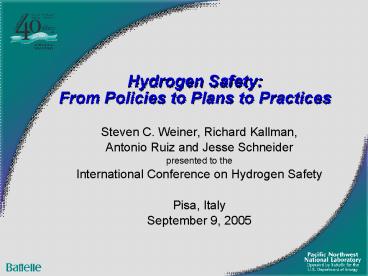Hydrogen Safety: From Policies to Plans to Practices - PowerPoint PPT Presentation
1 / 15
Title:
Hydrogen Safety: From Policies to Plans to Practices
Description:
Do you use established qualitative or quantitative measures or one(s) of your own design? ... ignites or is sufficient to sustain a flame if ignited, ... – PowerPoint PPT presentation
Number of Views:25
Avg rating:3.0/5.0
Title: Hydrogen Safety: From Policies to Plans to Practices
1
Hydrogen SafetyFrom Policies to Plans to
Practices
- Steven C. Weiner, Richard Kallman,
- Antonio Ruiz and Jesse Schneider
- presented to the
- International Conference on Hydrogen Safety
- Pisa, Italy
- September 9, 2005
2
Hydrogen Safety
3
The Context for Safety and the Hydrogen Economy
- Hydrogen use has enjoyed a notable safety record.
- Introduction of hydrogen as a commercial energy
carrier is a whole new ballgame. - Safety with hydrogen is as important now if not
more so than when the hydrogen economy becomes a
reality. - Public trust can be a fragile commodity.
- Catastrophic accidents may delay or even preclude
hydrogens intended implementation.
4
Hydrogen Safety Program Goal
- Develop and implement the practices and
procedures that will ensure safety in the
operation, handling, and use of hydrogen and
hydrogen systems for all DOE projects and to
utilize these practices and lessons learned to
promote the safe use of hydrogen throughout the
emerging hydrogen economy
Ref HFCIT Multi-Year Program Plan, Nov 15, 2004
5
Hydrogen Safety Review PanelKey Objectives
- Provide expertise and guidance to the DOE and
assist with identifying areas of additional
research, learnings and best practices. - Integrate safety planning into all DOE
project-funding procurements to ensure that all
projects address and incorporate hydrogen safety
requirements. - Provide input for a handbook of Best Management
Practices for Safety (2007)
6
Hydrogen Safety Review Panel
7
An Overview of Panel Initiatives
- Project Safety Plans
- Guidance for Safety Aspects of Proposed Hydrogen
Projects - Provide review and comment
- Safety Reviews Telephone Interviews and Site
Visits - Share and discuss learnings and new insights that
bear on safety - Address project-specific safety issues
- Identify project-specific findings that can have
a broader benefit in the DOE program - Project Safety Questionnaires
8
Identifying and AnalyzingSafety Vulnerabilities
- The right team, the right leader, the right
techniques - Documentation with sufficient detail
- Time
- Pitfalls
- Lack of understanding by management of the time
commitment needed to produce a successful study - Lack of experience by the team leader
- Use of outdated documents
- Failure to address all aspects of operation
- Failure to consider existing safeguards
9
Safety Plan Expectations
- Does the plan provide a good sense of how the
policies and procedures of the organization are
implemented down to the project and staff levels
for the specific project? - Does the plan reflect the key areas of sound and
thoughtful identification and analysis of safety
vulnerabilities, risk mitigation and
communications? - Does the plan reflect a desired nature that it be
a living document and therefore, discuss safety
considerations relevant to the course of the
project, e.g. management of change, dissemination
of learnings, etc.?
10
Site Visit TemplateSafety Planning and QA
- Safety Vulnerabilities
- How do you assess the safety risks that are/will
be present during the implementation of your
project? Do you use established qualitative or
quantitative measures or one(s) of your own
design? - Risk Mitigation
- What approaches and methodologies are used to
reduce the identified risks? - Communications
- How are safety reviews conducted during the
design, development and operating phases of the
project? How are safety incidents and
near-misses documented and reported and the
resulting lessons learned shared?
11
Observations and Learnings
- Equipment Maintenance and Sensor Calibration
- Management of Change
- Safety Event Reporting
12
Safety Event ReportingIncidents and Near-Misses
- An incident is an event that results in
- a lost-time accident and/or injury to personnel,
- damage and/or unplanned downtime for equipment,
facilities or property, - impact to the public or environment,
- any hydrogen release that unintentionally ignites
or is sufficient to sustain a flame if ignited, - any hydrogen release which accumulates above the
lower flammability limits within an enclosed
space. - A near-miss is an event that under slightly
different circumstances could have become an
incident.
13
Summary
- Identification and analysis of safety
vulnerabilities, risk mitigation, and
communications are critical topics. - A safety plan should be a living document.
- A safety plan is a tool that should be utilized
to make sure overall safety practices are in
order and that safety is a priority.
14
Hydrogen Safety
15
Acknowledging.
- U.S. Department of Energys Hydrogen, Fuel Cells
and Infrastructure Technologies Program Office - Steven Chalk, Program Manager
- Pat Davis, Manager, Safety, Codes and Standards
- My co-authors
- International Conference on Hydrogen Safety































